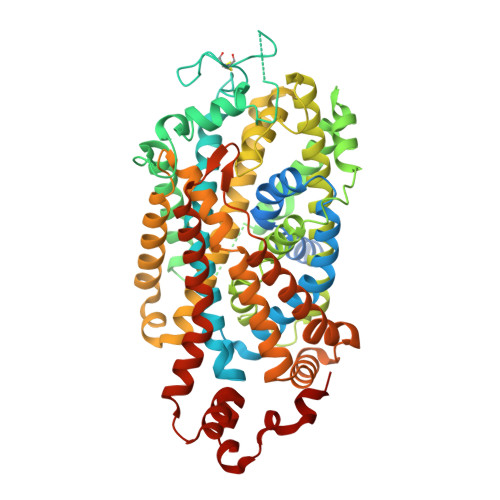Molecular basis of human noradrenaline transporter reuptake and inhibition.
Tan, J., Xiao, Y., Kong, F., Zhang, X., Xu, H., Zhu, A., Liu, Y., Lei, J., Tian, B., Yuan, Y., Yan, C.(2024) Nature 632: 921-929
- PubMed: 39048818
- DOI: https://doi.org/10.1038/s41586-024-07719-z
- Primary Citation of Related Structures:
8HFE, 8HFF, 8HFG, 8HFI, 8HFL, 8I3V, 8WGR, 8WGX, 8Z1L - PubMed Abstract:
Noradrenaline, also known as norepinephrine, has a wide range of activities and effects on most brain cell types 1 . Its reuptake from the synaptic cleft heavily relies on the noradrenaline transporter (NET) located in the presynaptic membrane 2 . Here we report the cryo-electron microscopy (cryo-EM) structures of the human NET in both its apo state and when bound to substrates or antidepressant drugs, with resolutions ranging from 2.5 Å to 3.5 Å. The two substrates, noradrenaline and dopamine, display a similar binding mode within the central substrate binding site (S1) and within a newly identified extracellular allosteric site (S2). Four distinct antidepressants, namely, atomoxetine, desipramine, bupropion and escitalopram, occupy the S1 site to obstruct substrate transport in distinct conformations. Moreover, a potassium ion was observed within sodium-binding site 1 in the structure of the NET bound to desipramine under the KCl condition. Complemented by structural-guided biochemical analyses, our studies reveal the mechanism of substrate recognition, the alternating access of NET, and elucidate the mode of action of the four antidepressants.
Organizational Affiliation:
Beijing Frontier Research Center for Biological Structure, State Key Laboratory of Membrane Biology, Tsinghua-Peking Joint Center for Life Sciences, School of Life Sciences, Tsinghua University, Beijing, China.
















